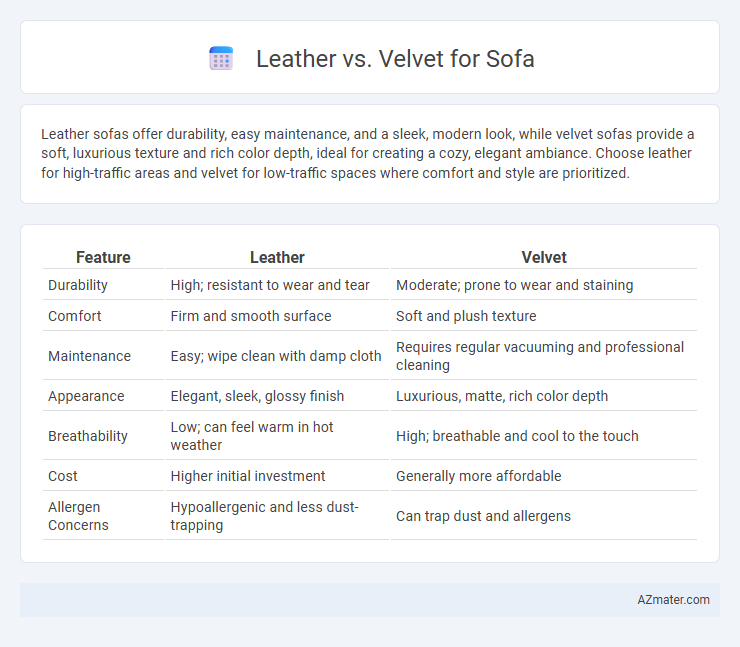Leather sofas offer durability, easy maintenance, and a sleek, modern look, while velvet sofas provide a soft, luxurious texture and rich color depth, ideal for creating a cozy, elegant ambiance. Choose leather for high-traffic areas and velvet for low-traffic spaces where comfort and style are prioritized.
Table of Comparison
| Feature | Leather | Velvet |
|---|---|---|
| Durability | High; resistant to wear and tear | Moderate; prone to wear and staining |
| Comfort | Firm and smooth surface | Soft and plush texture |
| Maintenance | Easy; wipe clean with damp cloth | Requires regular vacuuming and professional cleaning |
| Appearance | Elegant, sleek, glossy finish | Luxurious, matte, rich color depth |
| Breathability | Low; can feel warm in hot weather | High; breathable and cool to the touch |
| Cost | Higher initial investment | Generally more affordable |
| Allergen Concerns | Hypoallergenic and less dust-trapping | Can trap dust and allergens |
Introduction to Leather vs Velvet Sofas
Leather sofas offer durability, easy maintenance, and a sleek, timeless look, making them ideal for high-traffic living spaces. Velvet sofas provide a luxurious feel with a soft texture and vibrant color options, enhancing elegance and comfort in any room. Choosing between leather and velvet depends on lifestyle factors, design preferences, and desired sofa longevity.
Material Overview: Leather and Velvet
Leather sofas offer durability, easy maintenance, and a classic, sleek appearance, making them ideal for high-traffic living spaces. Velvet sofas provide a luxurious, soft texture with rich color depth, but require more careful cleaning and are prone to wear in busy households. Choosing between leather and velvet depends on lifestyle needs, with leather excelling in longevity and velvet prioritizing comfort and elegance.
Aesthetic Appeal: Style and Design
Leather sofas offer a sleek, timeless look with a smooth surface that complements modern and minimalist interiors, while velvet sofas provide a rich, luxurious texture that adds depth and softness to traditional or eclectic designs. Leather's natural sheen highlights clean lines and structured shapes, creating an elegant yet durable focal point in living rooms. Velvet upholstery, available in a variety of vibrant colors, enhances visual warmth and invites tactile comfort, making it ideal for statement pieces in cozy, stylish spaces.
Comfort Comparison: Feel and Texture
Leather sofas offer a smooth, cool surface that becomes softer and more supple with use, providing a firm yet comfortable seating experience. Velvet sofas boast a plush, velvety texture that feels soft and luxurious against the skin, ideal for those who prioritize warmth and coziness. The choice between leather and velvet hinges on whether a sleek, durable feel or a cushioned, inviting softness is preferred for daily comfort.
Durability and Longevity
Leather sofas offer superior durability with natural resistance to wear, scratches, and spills, making them ideal for high-traffic areas. Velvet, while luxurious and soft, tends to show signs of wear more quickly, such as piling and fading, especially in homes with pets or frequent use. For long-term longevity, leather maintains its appearance and structural integrity better than velvet, which requires more delicate care to preserve its texture and color.
Maintenance and Cleaning Requirements
Leather sofas require regular wiping with a damp cloth to remove dust and occasional conditioning to prevent cracking and maintain suppleness. Velvet sofas demand more frequent vacuuming and gentle brushing to keep the fabric soft and free of dust, with spot cleaning necessary for stains using upholstery-specific detergents. Both materials have distinct maintenance needs, with leather being easier to wipe clean and velvet needing more delicate care to preserve texture.
Cost and Value Considerations
Leather sofas typically command a higher upfront cost due to the durability and premium nature of genuine leather, while velvet sofas often offer a more affordable price point with luxurious aesthetics. In terms of long-term value, leather provides greater resistance to wear, spills, and fading, making it a cost-effective option over time despite initial expenses. Velvet, although rich in texture and color variety, may require more maintenance and careful handling, potentially increasing upkeep costs and impacting overall value.
Pet and Kid Friendliness
Leather sofas provide a durable, easy-to-clean surface that withstands pet scratches and spills, making them ideal for homes with kids and pets. Velvet sofas, while luxurious, tend to attract pet hair and can stain more easily, requiring frequent maintenance to keep their appearance. Choosing leather enhances longevity and hygiene in busy households, whereas velvet requires more careful upkeep to remain pet and kid-friendly.
Environmental Impact and Sustainability
Leather sofas, derived from animal hides, have a significant environmental footprint due to livestock farming's high greenhouse gas emissions and water consumption, while chemical tanning processes contribute to pollution. Velvet sofas, often made from synthetic fibers, can raise sustainability concerns because of microplastic pollution and energy-intensive production methods, although plant-based or recycled velvet alternatives reduce environmental impact. Choosing sustainably sourced leather or eco-friendly velvet fabrics can help minimize negative environmental effects and promote a greener home interior.
Choosing the Right Sofa Material for Your Home
Choosing the right sofa material involves considering durability, comfort, and maintenance requirements. Leather offers a sleek, long-lasting finish that is easy to clean and ideal for high-traffic areas, while velvet provides a soft, luxurious texture that adds warmth and elegance but requires more care to prevent stains and wear. Prioritizing factors like lifestyle, household size, and aesthetic preferences ensures selection of the perfect sofa fabric to complement your home's ambiance and functionality.

Infographic: Leather vs Velvet for Sofa
 azmater.com
azmater.com